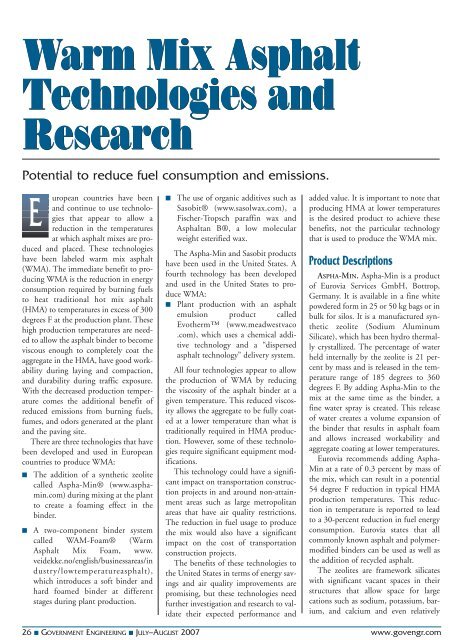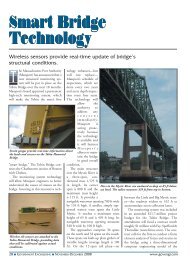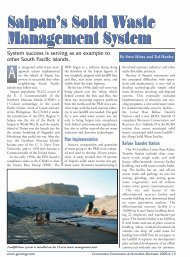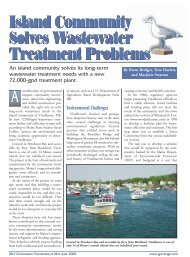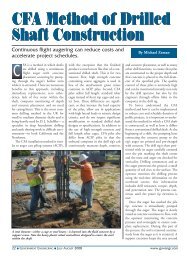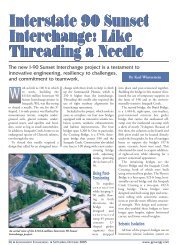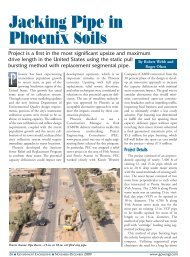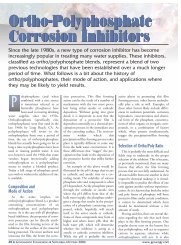Warm Mix Asphalt Technologies and Research Warm Mix Asphalt
Warm Mix Asphalt Technologies and Research Warm Mix Asphalt
Warm Mix Asphalt Technologies and Research Warm Mix Asphalt
Create successful ePaper yourself
Turn your PDF publications into a flip-book with our unique Google optimized e-Paper software.
<strong>Warm</strong> <strong>Mix</strong> <strong>Asphalt</strong><br />
<strong>Technologies</strong> <strong>and</strong><br />
<strong>Research</strong><br />
Potential to reduce fuel consumption <strong>and</strong> emissions.<br />
E<br />
uropean countries have been<br />
<strong>and</strong> continue to use technologies<br />
that appear to allow a<br />
reduction in the temperatures<br />
at which asphalt mixes are produced<br />
<strong>and</strong> placed. These technologies<br />
have been labeled warm mix asphalt<br />
(WMA). The immediate benefit to producing<br />
WMA is the reduction in energy<br />
consumption required by burning fuels<br />
to heat traditional hot mix asphalt<br />
(HMA) to temperatures in excess of 300<br />
degrees F at the production plant. These<br />
high production temperatures are needed<br />
to allow the asphalt binder to become<br />
viscous enough to completely coat the<br />
aggregate in the HMA, have good workability<br />
during laying <strong>and</strong> compaction,<br />
<strong>and</strong> durability during traffic exposure.<br />
With the decreased production temperature<br />
comes the additional benefit of<br />
reduced emissions from burning fuels,<br />
fumes, <strong>and</strong> odors generated at the plant<br />
<strong>and</strong> the paving site.<br />
There are three technologies that have<br />
been developed <strong>and</strong> used in European<br />
countries to produce WMA:<br />
■ The addition of a synthetic zeolite<br />
called Aspha-Min® (www.asphamin.com)<br />
during mixing at the plant<br />
to create a foaming effect in the<br />
binder.<br />
■<br />
A two-component binder system<br />
called WAM-Foam® (<strong>Warm</strong><br />
<strong>Asphalt</strong> <strong>Mix</strong> Foam, www.<br />
veidekke.no/english/businessareas/in<br />
dustry/lowtemperatureasphalt),<br />
which introduces a soft binder <strong>and</strong><br />
hard foamed binder at different<br />
stages during plant production.<br />
■ The use of organic additives such as<br />
Sasobit® (www.sasolwax.com), a<br />
Fischer-Tropsch paraffin wax <strong>and</strong><br />
<strong>Asphalt</strong>an B®, a low molecular<br />
weight esterified wax.<br />
The Aspha-Min <strong>and</strong> Sasobit products<br />
have been used in the United States. A<br />
fourth technology has been developed<br />
<strong>and</strong> used in the United States to produce<br />
WMA:<br />
■ Plant production with an asphalt<br />
emulsion product called<br />
Evotherm (www.meadwestvaco<br />
.com), which uses a chemical additive<br />
technology <strong>and</strong> a “dispersed<br />
asphalt technology” delivery system.<br />
All four technologies appear to allow<br />
the production of WMA by reducing<br />
the viscosity of the asphalt binder at a<br />
given temperature. This reduced viscosity<br />
allows the aggregate to be fully coated<br />
at a lower temperature than what is<br />
traditionally required in HMA production.<br />
However, some of these technologies<br />
require significant equipment modifications.<br />
This technology could have a significant<br />
impact on transportation construction<br />
projects in <strong>and</strong> around non-attainment<br />
areas such as large metropolitan<br />
areas that have air quality restrictions.<br />
The reduction in fuel usage to produce<br />
the mix would also have a significant<br />
impact on the cost of transportation<br />
construction projects.<br />
The benefits of these technologies to<br />
the United States in terms of energy savings<br />
<strong>and</strong> air quality improvements are<br />
promising, but these technologies need<br />
further investigation <strong>and</strong> research to validate<br />
their expected performance <strong>and</strong><br />
added value. It is important to note that<br />
producing HMA at lower temperatures<br />
is the desired product to achieve these<br />
benefits, not the particular technology<br />
that is used to produce the WMA mix.<br />
Product Descriptions<br />
ASPHA-MIN. Aspha-Min is a product<br />
of Eurovia Services GmbH, Bottrop,<br />
Germany. It is available in a fine white<br />
powdered form in 25 or 50 kg bags or in<br />
bulk for silos. It is a manufactured synthetic<br />
zeolite (Sodium Aluminum<br />
Silicate), which has been hydro thermally<br />
crystallized. The percentage of water<br />
held internally by the zeolite is 21 percent<br />
by mass <strong>and</strong> is released in the temperature<br />
range of 185 degrees to 360<br />
degrees F. By adding Aspha-Min to the<br />
mix at the same time as the binder, a<br />
fine water spray is created. This release<br />
of water creates a volume expansion of<br />
the binder that results in asphalt foam<br />
<strong>and</strong> allows increased workability <strong>and</strong><br />
aggregate coating at lower temperatures.<br />
Eurovia recommends adding Aspha-<br />
Min at a rate of 0.3 percent by mass of<br />
the mix, which can result in a potential<br />
54 degree F reduction in typical HMA<br />
production temperatures. This reduction<br />
in temperature is reported to lead<br />
to a 30-percent reduction in fuel energy<br />
consumption. Eurovia states that all<br />
commonly known asphalt <strong>and</strong> polymermodified<br />
binders can be used as well as<br />
the addition of recycled asphalt.<br />
The zeolites are framework silicates<br />
with significant vacant spaces in their<br />
structures that allow space for large<br />
cations such as sodium, potassium, barium,<br />
<strong>and</strong> calcium <strong>and</strong> even relatively<br />
26 ■ GOVERNMENT ENGINEERING ■ JULY–AUGUST 2007 www.govengr.com
large molecules <strong>and</strong> cation groups, such<br />
as water. In the more useful zeolites, the<br />
spaces are interconnected <strong>and</strong> form long<br />
wide channels of varying sizes depending<br />
on the mineral. These channels<br />
allow the easy movement of the resident<br />
ions <strong>and</strong> molecules into <strong>and</strong> out of the<br />
zeolite structure. The most well known<br />
use for zeolites is in water softeners.<br />
Zeolites are characterized by their ability<br />
to lose <strong>and</strong> absorb water without<br />
damage to their crystal structures. They<br />
can have the water in their structures<br />
driven off by heat <strong>and</strong> other solutions<br />
pushed through the structure. They can<br />
then act as a delivery system for the new<br />
fluid.<br />
WAM-FOAM. WAM-Foam is a product<br />
of a joint venture between Shell<br />
International Petroleum Company Ltd.,<br />
London, <strong>and</strong> Kolo-Veidekke, Oslo,<br />
Norway. In WAM-Foam the binder is<br />
formed using two separate binder components<br />
in the mixing stage. By dividing<br />
the binder into two separate components,<br />
a soft binder <strong>and</strong> a hard binder in<br />
foam form, lower asphalt mixture production<br />
temperatures can be achieved.<br />
The soft binder component is mixed<br />
with the aggregate in the first stage at<br />
about 230 degrees F to achieve full<br />
aggregate coverage. The hard binder<br />
component is mixed in a second stage<br />
into the pre-coated aggregates in the<br />
form of foam. Rapid evaporation of<br />
water by injecting cold water into the<br />
heated hard binder as it is added to the<br />
mix produces a large volume of foam.<br />
The hard binder foam combines with<br />
the soft binder to achieve the required<br />
final composition <strong>and</strong> properties of the<br />
asphalt product.<br />
Shell states that WAM-Foam’s success<br />
depends on careful selection of the soft<br />
<strong>and</strong> hard components. In some cases it<br />
is recommended to use an adhesion<br />
improver in the first mixing stage. Shell<br />
also states that initial coating of the<br />
aggregate in the first mixing stage is vital<br />
to prevent water from reaching the<br />
binder <strong>and</strong> aggregate interface <strong>and</strong><br />
entering the aggregate <strong>and</strong> that water<br />
must be removed from the asphalt mix<br />
to ensure a high quality end product.<br />
Shell reports that the decreased production<br />
temperatures of the WAM-Foam<br />
process can lead to plant fuel savings of<br />
30 percent,<br />
which<br />
results in<br />
a 30 perc<br />
e n t<br />
reduction in<br />
CO2 emissions.<br />
SASOBIT. Sasobit<br />
is a product of Sasol<br />
Wax (formerly Schümann<br />
Sasol), South Africa. Sasobit is<br />
described as a modifier or “asphalt<br />
flow improver.” It is available in 2, 5,<br />
20, <strong>and</strong> 600 kg bags. On request it can<br />
be supplied in flakes or powdered form.<br />
Sasobit is a fine crystalline, long chain<br />
aliphatic hydrocarbon produced from<br />
coal gasification using the Fischer-<br />
Tropsch (FT) process <strong>and</strong> is otherwise<br />
know as an FT paraffin wax.<br />
In the FT process, carbon monoxide<br />
is converted into a mixture of hydrocarbons<br />
having molecular chain lengths of<br />
1 to 100 carbon atoms <strong>and</strong> greater. The<br />
starting point for the process is synthesis<br />
gas, a mixture of carbon monoxide <strong>and</strong><br />
hydrogen (CO + H2) produced by gasification<br />
of coal, a process involving the<br />
treating of white-hot hard coal or coke<br />
with a blast of steam. The gas is manufactured<br />
in vast quantities for commercial<br />
use. It is important in the preparation<br />
of hydrogen <strong>and</strong> as a fuel in the<br />
making of steel <strong>and</strong> in other industrial<br />
processes. The synthesis gas is reacted in<br />
the presence of an iron or cobalt catalyst;<br />
heat is created <strong>and</strong> products such as<br />
methane, synthetic gasoline, waxes, <strong>and</strong><br />
alcohols are made. The liquid products<br />
are separated <strong>and</strong> the FT waxes are contained.<br />
The makers of Sasobit emphasize<br />
the difference between naturally occurring<br />
bituminous waxes <strong>and</strong> FT waxes<br />
in terms of their structure <strong>and</strong> physical<br />
properties. The difference reportedly<br />
arises from their much longer chain<br />
lengths <strong>and</strong> the fine crystalline structure<br />
of the FT waxes. The predominant<br />
chain length of the hydrocarbons<br />
in Sasobit is in a range of 40 to 115<br />
carbon atoms. The chain lengths of<br />
bituminous paraffin waxes naturally<br />
found in asphalt range from 22 to 45<br />
carbon atoms, resulting in a lower<br />
melting<br />
point<br />
than FT waxes.<br />
Sasol Wax states that the melting<br />
point of Sasobit is approximately 210<br />
degrees F <strong>and</strong> is completely soluble in<br />
asphalt binder at temperatures in excess<br />
of 240 degrees F. It produces a reduction<br />
in the binder viscosity. This enables production<br />
temperatures to be reduced by<br />
18 degrees to 54 degrees F. At temperatures<br />
below its melting point, Sasobit<br />
forms a lattice structure in the asphalt<br />
binder that is the basis for the reported<br />
stability of asphalts that contain Sasobit.<br />
At service temperatures, Sasobit modified<br />
asphalts are reported to display an<br />
increased resistance to rutting. In addition<br />
Sasol Wax reports improved “compactibility”<br />
with an increase in the<br />
degree of compaction for the same roller<br />
loading as unmodified asphalt.<br />
Sasol Wax recommends adding<br />
Sasobit at three percent by weight of the<br />
mix to gain the desired reduction in viscosity<br />
<strong>and</strong> should not exceed four percent<br />
due to the possible impact on the<br />
binder’s low temperature properties.<br />
Sasobit can be blended into hot binder<br />
at the blending plant using a simple stirrer.<br />
A high shear mixer is not required. It<br />
is anticipated that in-line blending of<br />
melted Sasobit with the asphalt binder<br />
stream at the plant will be finalized in<br />
the near future. Direct blending of solid<br />
Sasobit at the plant is not recommended<br />
because it will not give a homogeneous<br />
distribution of Sasobit in the asphalt.<br />
EVOTHERM. Evotherm is a product<br />
developed by MeadWestvaco <strong>Asphalt</strong><br />
Innovations, Charleston, S.C. Evotherm<br />
uses a chemical additive technology <strong>and</strong><br />
www.govengr.com GOVERNMENT ENGINEERING ■ JULY–AUGUST 2007 ■ 27
a “Dispersed <strong>Asphalt</strong> Technology” delivery<br />
system. MeadWestvaco states that by<br />
using this technology a unique chemistry<br />
customized for aggregate compatibility<br />
is delivered into a dispersed<br />
asphalt phase (emulsion). During production,<br />
the asphalt emulsion with<br />
Evotherm chemical package is used in<br />
place of the traditional asphalt binder.<br />
The emulsion is then mixed with the<br />
aggregate in the HMA plant.<br />
MeadWestvaco reports that this chemistry<br />
provides aggregate coating, workability,<br />
adhesion, <strong>and</strong> improved compaction<br />
with no change in materials or<br />
job mix formula required.<br />
MeadWestvaco reports that field testing<br />
has demonstrated a 100-degree F<br />
reduction in production temperatures.<br />
MeadWestvaco also reports that the<br />
decreased production temperatures of<br />
the Evotherm process can lead to plant<br />
energy savings of 55 percent; which<br />
results in a 45 percent reduction in CO2<br />
<strong>and</strong> SO2 emissions, a 60 percent reduction<br />
in NOX, a 41 percent reduction in<br />
total organic material, <strong>and</strong> benzene soluble<br />
fractions below detectable limits.<br />
ASPHALTAN B (NOT USED IN THE<br />
UNITED STATES). <strong>Asphalt</strong>an B is a product<br />
of Romonta GmbH, Amsdorf,<br />
Germany. It is available in granular form<br />
in 25 kg bags. Created specifically for<br />
“rolled asphalt,” <strong>Asphalt</strong>an B is a mixture<br />
of substances based on Montan wax<br />
constituents <strong>and</strong> higher molecular<br />
weight hydrocarbons.<br />
Crude Montan Wax is found in<br />
Germany, Eastern Europe, <strong>and</strong> areas of<br />
the United States in certain types of lignite<br />
or brown coal deposits that have<br />
formed over millions of years by the<br />
transformation of fossilized sub-tropical<br />
vegetation that flourished in the Tertiary<br />
Period. Wax that once protected the<br />
plant leaves from extremes of climate<br />
did not decompose, but instead<br />
enriched the coal. Due to its high stability<br />
<strong>and</strong> insolubility in water, the wax has<br />
survived over long geological time periods.<br />
After mining, the Montan Wax is<br />
extracted from the coal by means of a<br />
toluene solvent that is distilled from the<br />
wax solution <strong>and</strong> removed with super<br />
heated steam. Romonta GmbH has a<br />
global market share of 80 percent in the<br />
crude mined wax products sector.<br />
Romonta recommends adding<br />
<strong>Asphalt</strong>an B at two to four percent by<br />
weight. It can be added to the asphalt<br />
mixing plant or directly at the binder<br />
producer <strong>and</strong> can also be added to polymer-modified<br />
binders. The melting<br />
point of <strong>Asphalt</strong>an B is about 210<br />
degrees F. Similar to FT waxes, it acts as<br />
an “asphalt flow improver” with associated<br />
reduced production temperatures.<br />
Romonta does not specify how much<br />
the production temperature can be lowered.<br />
Like FT waxes, Romonta also<br />
reports increased compactibility <strong>and</strong><br />
resistance to rutting.<br />
Initial <strong>Research</strong><br />
The National <strong>Asphalt</strong> Pavement<br />
Association (NAPA, www.hotmix.org)<br />
in cooperation with the Federal<br />
Highway Administration (FHWA) proposed<br />
a research program to investigate<br />
the performance of WMA products.<br />
Initial research was conducted on the<br />
feasibility of using these technologies in<br />
the United States through a cooperative<br />
agreement between the National Center<br />
for <strong>Asphalt</strong> Technology (NCAT,<br />
www.ncat.us) <strong>and</strong> FHWA. This study<br />
also included additional monetary support<br />
from NAPA <strong>and</strong> the individual<br />
technology providers. This initial<br />
research has been completed <strong>and</strong> the<br />
findings have been published by NCAT.<br />
The reports can be found on their website<br />
published as:<br />
■ Evaluation of Evotherm for Use in<br />
<strong>Warm</strong> <strong>Mix</strong> <strong>Asphalt</strong> (Report 06-02),<br />
by Graham C. Hurley<br />
<strong>Research</strong> Engineer, National Center<br />
for <strong>Asphalt</strong> Technology, Auburn<br />
University, Auburn, AL, <strong>and</strong> Brian D.<br />
Prowell, Assistant Director, National<br />
Center for <strong>Asphalt</strong> Technology, Auburn<br />
University. The report concluded:<br />
“Evotherm was shown to improve the<br />
compactibility of mixtures in both the<br />
Superpave Gyratory Compactor (SGC)<br />
<strong>and</strong> vibratory compactor. Statistics indicated<br />
an overall reduction in air voids.<br />
Improved compaction was noted at<br />
temperatures as low as 190 degrees F.<br />
The addition of Evotherm does not statistically<br />
affect the resilient modulus of<br />
an asphalt mix nor does it increase the<br />
rutting potential of an asphalt mix as<br />
measured by the <strong>Asphalt</strong> Pavement<br />
Analyzer. The rutting potential did<br />
increase with decreasing mixing <strong>and</strong><br />
compaction temperatures, which may<br />
be related to the decreased aging of the<br />
binder resulting from the lower mixing<br />
<strong>and</strong> compaction temperatures. There<br />
was no evidence of a difference in indirect<br />
tensile strength gain with time for<br />
the mixes containing Evotherm as compared<br />
to the control mixes, indicating<br />
that a WMA containing Evotherm can<br />
be quickly opened to traffic. The lower<br />
compaction temperature used when<br />
producing WMA with Evotherm or any<br />
WMA additive may increase the potential<br />
for moisture damage. Overall,<br />
Evotherm appears to be a viable tool for<br />
reducing mixing <strong>and</strong> compaction temperatures<br />
that can be readily added to<br />
hot mix asphalt. Reductions in mixing<br />
<strong>and</strong> compaction temperatures are<br />
expected to reduce fuel costs, reduce<br />
emissions, <strong>and</strong> widen the winter paving<br />
window.”<br />
■ Evaluation of Sasobit for Use in <strong>Warm</strong><br />
<strong>Mix</strong> <strong>Asphalt</strong> (Report 05-06), by<br />
Hurley <strong>and</strong> Prowell, which concluded:<br />
“Sasobit was shown to improve<br />
the compactibility of mixtures in<br />
both the SGC <strong>and</strong> vibratory compactor.<br />
Statistics indicated an overall<br />
reduction in air voids. Improved<br />
compaction was noted at temperatures<br />
as low as 190 degrees F. The<br />
addition of Sasobit does not affect<br />
the resilient modulus of an asphalt<br />
mix nor does it increase the rutting<br />
potential of an asphalt mix as measured<br />
by the <strong>Asphalt</strong> Pavement<br />
Analyzer. The rutting potential did<br />
increase with decreasing mixing <strong>and</strong><br />
compaction temperatures, which<br />
may be related to the decreased<br />
aging of the binder resulting from<br />
the lower temperatures as well as<br />
from the anti-aging properties of<br />
Sasobit. There was no evidence of<br />
differing strength gain with time for<br />
the mixes containing Sasobit as compared<br />
to the control mixes indicating<br />
that a prolonged cure time before<br />
opening to traffic is not an issue. The<br />
lower compaction temperature used<br />
when producing warm asphalt with<br />
Sasobit or any such similar <strong>Warm</strong><br />
28 ■ GOVERNMENT ENGINEERING ■ JULY–AUGUST 2007 www.govengr.com
■<br />
<strong>Mix</strong> additive may increase the<br />
potential for moisture damage.<br />
Overall, Sasobit appears to be a<br />
viable tool for reducing mixing <strong>and</strong><br />
compaction temperatures that can<br />
be readily added to hot mix asphalt.<br />
Reductions in mixing <strong>and</strong> compaction<br />
temperatures are expected to<br />
reduce fuel costs, reduce emissions,<br />
widen the winter paving window,<br />
<strong>and</strong> facilitate specialized applications,<br />
such as airport runway construction,<br />
where rapid opening to<br />
traffic is essential.”<br />
Evaluation of Aspha-Min Zeolite for<br />
Use in <strong>Warm</strong> <strong>Mix</strong> <strong>Asphalt</strong> (Report 05-<br />
04), by Hurley <strong>and</strong> Prowell, which<br />
concluded: “A laboratory study was<br />
conducted to determine the applicability<br />
of Aspha-Min to typical paving<br />
operations <strong>and</strong> environmental conditions<br />
commonly found in the United<br />
States, including the performance of<br />
the mixes in quick traffic turn-over<br />
situations <strong>and</strong> high temperature conditions.<br />
Aspha-Min was shown to<br />
improve the compactibility of mixtures<br />
in both the SGC <strong>and</strong> vibratory<br />
compactor. Statistics indicated an<br />
average reduction in air voids of 0.65<br />
percent. Improved compaction was<br />
noted at temperatures as low as 190<br />
degrees F. The addition of zeolite<br />
does not affect the resilient modulus<br />
of an asphalt mix. The addition of<br />
zeolite does not increase the rutting<br />
potential of an asphalt mix as measured<br />
by the <strong>Asphalt</strong> Pavement<br />
Analyzer. The rutting potential did<br />
increase with decreasing mixing <strong>and</strong><br />
compaction temperatures, which<br />
may be related to the decreased aging<br />
of the binder. There was no evidence<br />
of differing strength gain with time<br />
for the mixes containing zeolite as<br />
compared to the control mixes.<br />
There is no indication that HMA<br />
containing Aspha-Min requires a<br />
cure period prior to opening to traffic.<br />
The lower compaction temperature<br />
used when producing warm<br />
asphalt with Aspha-Min may<br />
increase the potential for moisture<br />
damage as indicated by tensile<br />
strength ratio (TSR) <strong>and</strong> Hamburg<br />
tests. However, the addition of<br />
hydrated lime mitigated this effect.<br />
“A demonstration project was constructed<br />
using Aspha-Min zeolite in<br />
Orl<strong>and</strong>o, FL. The warm mix production<br />
<strong>and</strong> compaction temperatures were 35<br />
degrees F less than those used for the<br />
control (about 300 degrees F compaction<br />
temperature). The laboratory<br />
test results on the field mix coincide<br />
with the laboratory study. Cores taken<br />
one year after placement indicated no<br />
increased evidence of moisture damage<br />
as compared to the control mix. Overall,<br />
Aspha-Min zeolite appears to be a viable<br />
tool for reducing mixing <strong>and</strong> compaction<br />
temperatures that can be readily<br />
added to hot mix asphalt. Reductions in<br />
mixing <strong>and</strong> compaction temperatures<br />
are expected to reduce fuel costs <strong>and</strong><br />
emissions <strong>and</strong> also widen the winter<br />
paving window.”<br />
The National Cooperative Highway<br />
<strong>Research</strong> Program has approved research<br />
Project 09-43 “<strong>Mix</strong> Design Practices for<br />
<strong>Warm</strong> <strong>Mix</strong> <strong>Asphalt</strong> <strong>Technologies</strong>” for<br />
fiscal year 2007, with completion scheduled<br />
for 2010. The objective of this<br />
research project is to develop a performance<br />
based mix design procedure for<br />
warm mix asphalt in the form of a manual<br />
of practice. Additional information<br />
can be found at<br />
www4.trb.org/trb/crp.nsf/All+Projects/<br />
NCHRP+9-43.<br />
The FHWA Office of Pavement<br />
Technology is actively involved with all<br />
these research projects <strong>and</strong> demonstrations<br />
<strong>and</strong> is also working in cooperation<br />
with FHWA Turner-Fairbank Highway<br />
<strong>Research</strong> Center’s (TFHRC)<br />
Bituminous <strong>Mix</strong>tures Laboratory to<br />
develop <strong>and</strong> monitor WMA demonstration<br />
projects <strong>and</strong> research <strong>and</strong> also to<br />
advance the knowledge <strong>and</strong> state of<br />
practice of these materials <strong>and</strong> technologies.<br />
FHWA will actively support further<br />
WMA research <strong>and</strong> validation<br />
through material sampling <strong>and</strong> performance<br />
testing provided through the<br />
Office of Pavement Technology’s Mobile<br />
<strong>Asphalt</strong> <strong>Mix</strong>ture Testing Laboratory<br />
(MAMTL) in addition to continued<br />
WMA research activities at TFHRC.<br />
The MAMTL was on site for material<br />
sampling <strong>and</strong> testing during the<br />
Missouri Department of Transportation<br />
WMA demonstration project on Hall<br />
Street in St. Louis. This demonstration<br />
project included construction of asphalt<br />
pavements using the Aspha-Min,<br />
Sasobit, <strong>and</strong> Evotherm products by Pace<br />
Construction. A large amount of volumetric<br />
<strong>and</strong> performance specimens were<br />
immediately fabricated for testing in<br />
addition to loose mix sampled for later<br />
testing to investigate any effects due to<br />
reheating <strong>and</strong> residual moisture. The<br />
immediately fabricated specimen testing<br />
has been completed. A final report of<br />
the test results <strong>and</strong> findings will be published<br />
upon completion of all testing<br />
<strong>and</strong> analysis.<br />
The Transportation <strong>Research</strong> Board<br />
(www.trb.org) is conducting a detailed<br />
evaluation study to assess the performance<br />
of WMA mixes <strong>and</strong> pavements<br />
both in field test sections <strong>and</strong> in the<br />
controlled environment of an accelerated<br />
test facility. Sponsored by the Federal<br />
Highway Administration, the performing<br />
organization is the University of<br />
Ohio, Athens, OH. Primary objectives<br />
of the research are:<br />
■ To conduct a detailed laboratory<br />
study to evaluate the engineering<br />
<strong>and</strong> physical properties of WMA<br />
mixtures.<br />
■<br />
■<br />
■<br />
■<br />
■<br />
To build <strong>and</strong> test pavement sections<br />
containing selected mixtures as a<br />
wearing course.<br />
To examine the influence of pavement<br />
thickness on the tensile strain<br />
developed at the bottom of the perpetual<br />
pavement layer.<br />
To monitor <strong>and</strong> test pavement sections.<br />
To compare the performance of<br />
WMA mixtures <strong>and</strong> pavements with<br />
that of conventional HMA.<br />
To document the performance of<br />
perpetual pavements containing<br />
WMA<br />
■ To assess the advantages of WMA<br />
over conventional HMA in regard to<br />
reduced energy utilization <strong>and</strong> fume<br />
emanation during processing <strong>and</strong><br />
placement.<br />
This project is expected to be completed<br />
in August 2008.<br />
GE<br />
www.govengr.com GOVERNMENT ENGINEERING ■ JULY–AUGUST 2007 ■ 29


